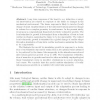Free Online Productivity Tools
i2Speak
i2Symbol
i2OCR
iTex2Img
iWeb2Print
iWeb2Shot
i2Type
iPdf2Split
iPdf2Merge
i2Bopomofo
i2Arabic
i2Style
i2Image
i2PDF
iLatex2Rtf
Sci2ools
86
Voted
FIMH
2007
Springer
2007
Springer
Constitutive Modeling of Cardiac Tissue Growth
Abstract. Long term responses of the heart to e.g. infarction or surgical intervention are related to response of the tissue to changes in the mechanical environment. The tissue response is likely to involve (local) change of mass. Implementation of the associated inhomogeneous change in volume for a complex geometry is cumbersome. In the present study, we propose a computational framework for finite volumetric growth. The local stimulus for growth is determined from a simulation of beat to beat cardiac mechanics, assuming the tissue to be incompressible. The related local volumetric growth is translated in a global change of cardiac shape through a simulation of long term cardiac mechanics, assuming the tissue to be compressible. We illustrate the model by simulating growth in response to a deviation of end-diastolic sarcomeric strain from a set optimal value assumed to be preferred by the tissue. Inhomogeneity in the stimulus was reduced after inhomogeneous growth of up to 25%. The ...
| Added | 07 Jun 2010 |
| Updated | 07 Jun 2010 |
| Type | Conference |
| Year | 2007 |
| Where | FIMH |
| Authors | Wilco Kroon, Tammo Delhaas, Theo Arts, Peter Bovendeerd |
Comments (0)

